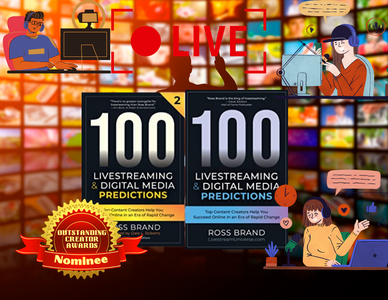|
Score: 92/100 (9.2 out of 10)
“100 Livestreaming & Digital Media Predictions” includes valuable contributions from many distinguished podcast guests like Dale L. Roberts, Tim McDonald, Jon Burk, and Chetachi Egwu, PhD, on the future of livestreaming and digital media. Ross Brand himself is an expert on the topic of livestreaming, even said by Brad Friedman to be the “King” of the medium. Brand celebrated the 5th anniversary of Livestream Universe during the livestreaming party from which most of the information in this book comes from. The livestreaming party seems to have taken many hours and included dozens of guests. This must've been a monumental undertaking with so many moving pieces. Some of the guests like Chris Krimitsos are even caught in between meetings or other business during the party. We were incredibly excited to read this book for numerous reasons. For one, Ross Brand is the man. Second, the line-up of guests is top-notch, full of successful business owners and Internet personalities including ones we personally admire. Third, some of us are just really into social media and livestreaming platforms like Twitch. We've probably spend hours upon hours upon hours on Twitch in 2020-2021, and all of us had at least some experience on Zoom during the pandemic. Zoom was as essential as money itself during that time when everything was locked down. If we were going to be absolutely brutally honest, there was a slight tinge of disappointment in consuming this book, especially considering how excited we were to read it and that the Amazon summary calls this a “Guide” for content creators. For one, aside from the introduction and conclusion, this book really isn't presented and structured like a traditional self-help or educational text. Instead, this is mostly one big, huge transcript taken primarily from one big, long livestream (and others). If you think you're getting 353 pages of information and profound, prophetic insights, you're actually getting some of that and a ton of banter and predictions that are either vague or seem mostly common-sense. For example, we are told that microphone and video technology will improve or that more people will be using streaming because they're unable to meet in person. Technology is always improving. People were already streaming more and using Zoom more at the time of the recordings. That's similar to saying that the sun will rise tomorrow. Now, you could argue that if Abraham Lincoln or Michio Kaku (who is always saying profound, wild stuff) told you that the sun would rise tomorrow, it would be profoundly more significant because of who is saying it. You'd be right. You could argue that this is what this book is like: you're hearing mostly common sense things from people who generally know what they're talking about. So, there is still tremendous value in it. Perhaps we were just expecting too much, like for one of these guests to bust out a big huge secret project or insights so profound that would change the technological sphere forever. The grand majority of these predictions are very modest. And as far as banter goes, you hear about Dale L. Roberts's joking about being shorted some green M&Ms, Ross Brand telling Chef Daniella Malfitano how hungry he is and that he hasn't eaten in five hours, the fact that Jon Burk is rushing and late to a pitch meeting so can't talk long. This can be fun and interesting to read, but it depends on why you're reading this book. Most people will read this book because they have an interest in the subject and want to learn about livestreaming and digital media. So, the M&M talk creates a bit of a conundrum for those people who just want to consume the relevant information without jibber jabber. On the other hand, you could argue that Brand and his guests demonstrate how to livestream, network, and market effectively by being personable and using small talk. We were erroneously thinking that the author would do what most authors do with data: take it in and interpret it to the reader/audience in a synopsis or abstract. Imagine if you were reading a psychology book for the sake of learning, well, psychology, but the author of this psychology book presented you with 300 pages of conversations with clients in his clinic (their names hidden for patient confidentiality, of course). Thankfully, Brand must've realized that just presenting transcripts as is could be problematic because it would force readers to navigate through this small talk to get to the meat of the matter. To address this, the author actually created boxed sections for each guest that included their prediction(s) and/or main point. That was greatly appreciated. Brand also added some flavor to the book with a lot of screenshots of the livestream(s), making the book seem “lived in.” And it's just such a joy to see all of these smiling, happy faces interacting. With all that said, some of the best parts of this book are actually the prose. Why? Because if you're actually interested in starting or improving a livestreaming hobby or business, the prose supply tremendous information from the man himself including the type of microphone, getting paid as a creator, and the state of the industry. In a sense, if you're reading this book for informational purposes rather than entertainment or to support the author or his guests directly, then the introduction is incredibly helpful in that regard. This book is incredibly encouraging for new and aspiring creators, something that really jives with us. It makes you want to go out and buy the best mic and camera to get started right away! For that, we highly recommend it! Check it out!
0 Comments
Leave a Reply. |
Archives
July 2024
Categories |

 RSS Feed
RSS Feed